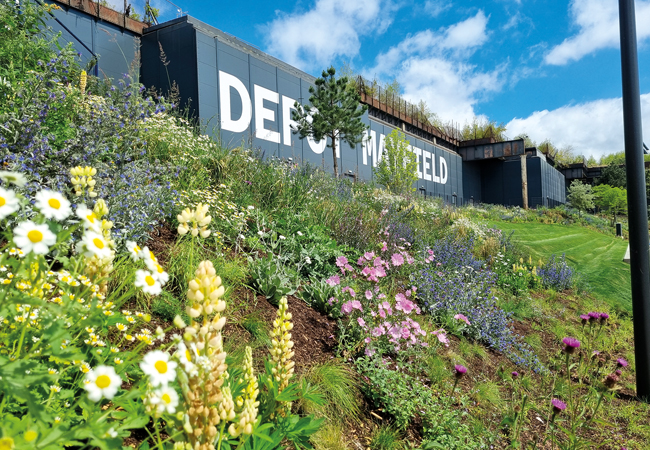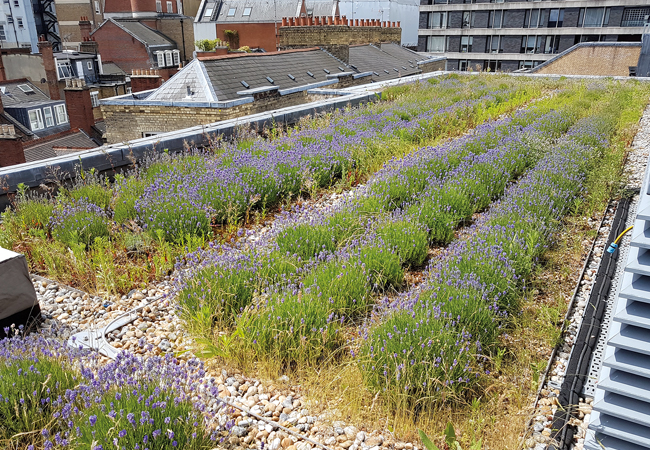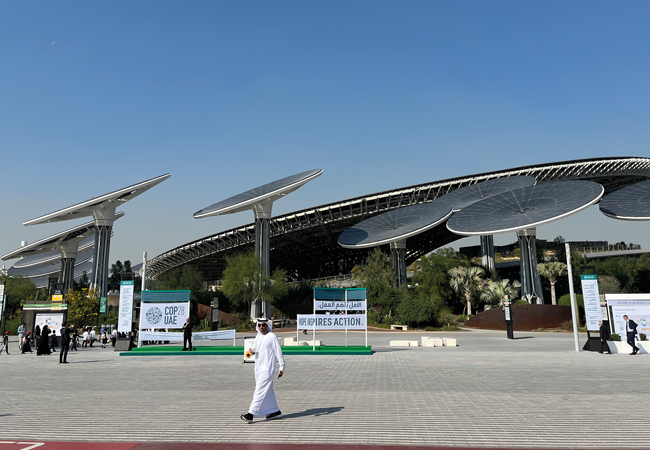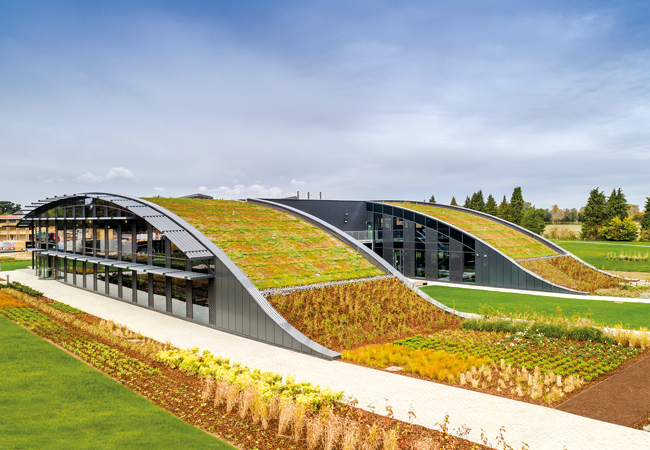
Buro Happold was the consultant at Mayfi eld, a 6.5- acre urban park in Manchester
The implementation of the new Biodiversity Net Gain (BNG) Regulation represents a significant shift towards a nature-positive and regenerative built environment.
Designers now have to pay attention to natural as well as mechanical plant under the new rules, which mandate that developers in England assess the pre-existing biodiversity of a project site and provide a BNG of 10% by the end of the scheme.
The building industry is resource-intensive, and a major contributor to habitat loss; it is responsible for 30% of biodiversity loss globally.1 Fiona Cousins, CIBSE president-elect, is a keen proponent of biodiversity in building design. ‘We need to take an approach that recognises every design decision as a pivotal factor in influencing climate change, social equity, and biodiversity,’ she said during a TEDx talk last year.
Introduced into the Environment Act 2001, the BNG Regulation became law under the Town and Country Planning Act on 12 February for larger sites, and will come into force on 2 April 2024 for smaller sites.
Developers must aim to deliver BNG gains on site; however, they can be achieved off site if necessary, or as a last resort, by buying statutory biodiversity offset credits. Failure to meet targets will incur financial penalties, including a fine of £5,000 if misleading information is included in biodiversity plans.

Lavender on a rooftop in the West End of London
The BNG policy follows a mitigation hierarchy, prioritising the preservation of existing resources on site. This means developers must look to avoid losing biodiversity in the first place. Consultant engineers have responded to the regulation and the growing focus on nature-led developments by building teams of biodiversity consultants.
Arup’s nature lead, Tom Butterworth, was once an academic who researched snails in Sri Lanka, and he has extensive experience in nature conservation. He welcomes the regulation: ‘It is not going to solve all our problems, but this is going to transform how development happens, where it happens, and the outcome in terms of biodiversity.
‘We’ve lost 60% of abundance of our species in the UK since 19702 – that’s staggering. We need to drive forward work for nature, because it’s the moral thing to do and because it’s crucial if we are going to deliver climate commitments; we can’t do one without the other.’
Aaron Grainger, associate director for ecology and biodiversity at Buro Happold, believes the mental health epidemic is also linked with access to nature. ‘Wellbeing is as inherently intertwined with biodiversity as the climate crisis is, and we’re becoming more and more disconnected,’ he says.
Butterworth believes biodiversity should be addressed from a project’s start. ‘Early involvement of biodiversity consultants is key, to assess risks and capitalise on biodiversity opportunities to make your asset as strong as possible’, he says, while Robert Winch, senior environmental, social and governance consultant at Hoare Lea, highlights a need for improved education.
‘The preparedness among our clients is varied; not everyone is fully aware of what BNG means. However, it’s positive to see developers looking to push well beyond the 10% increase’, he says.
Opting for green infrastructure over traditional ‘grey’ offers multiple benefits. Green roofs and walls can play a significant role when it comes to energy efficiency. By transpiring moisture, plants cool their surroundings, reducing the load on mechanical cooling systems. Incorporating green spaces can substantially lower peak summer temperatures, mitigating the urban heat island effect.
While green walls offer aesthetic appeal, their effectiveness depends on plant selection and maintenance. Butterworth highlights examples of effective green walls. ‘There’s a beautiful vertical meadow, full of native species, on a hotel in London Victoria. It’s designed so that the rainwater is harvested then pumped by solar power to feed the wall.’

A living wall in Mayfair, London, designed by Arup
As the climate changes, green solutions can also offer greater flexibility for adaptation – for example, sustainable urban drainage systems, such as ponds or lakes with reed banks. ‘Unlike rigid grey infrastructure, green systems can be modified easily to accommodate evolving needs, such as increased storm surges,’ Butterworth says.
In addition, green infrastructure contributes to improved air quality. Butterworth cites research in Torbay3, which found that trees, as well as storing and sequestering carbon, removed huge amounts of pollutants annually – 22.9 tonnes of ozone, 18 tonnes of particulate matter, and 7.9 tonnes of nitrogen oxide.
BNG not only enhances ecosystem services, but also increases financial and natural capital asset values, and provides long-term income prospects for landowners. ‘The evolving understanding of nature’s benefits is generating a market where land can yield returns beyond food production, encompassing clean air, water and biodiversity support,’ says Butterworth.
To maximise the impact of green infrastructure, Grainger stresses that a coordinated approach at local authority level is essential. ‘Integrated planning is needed to ensure green spaces function as interconnected habitats, not fragmented islands.’ He adds that post-construction monitoring will also be important to gauge the effectiveness of the regulation. ‘While intentions are good, local planning authorities face funding constraints, which complicates enforcement.’
Environmental net gain
Expanding on BNG, Environmental Net Gain (ENG) assesses other environmental factors, such as water resources, and assigns relative values to them to measure overall impact.
Along with initiatives such as the Taskforce on Nature-related Financial Disclosures, and standards such as GRI 101 Biodiversity reporting and science-based targets for nature, BNG and ENG offer consistency and guidance for businesses in assessing their global impacts and dependencies.
Embodied ecological impacts
The construction industry is incredibly resource-intensive, and accounts for approximately 50% of global resource extraction.
The UK Green Building Council is working on introducing an embodied ecological impacts tool to assess the environmental toll of resource extraction, manufacturing and transportation processes. Building services engineers can play a crucial role in delivering BNG by prioritising existing materials, promoting reuse and recycling, and optimising design. Embracing regenerative practices and minimising extraction can further reduce environmental harm.
Buro Happold’s Aaron Grainger agrees that the BNG policy alone cannot fully address the profound impacts of the construction industry on nature. ‘If global resource consumption mirrored that of the UK, we would require 2.6 Earths, highlighting the unsustainable nature of our current practices,’ he says.
BNG can also help improve resilience to climate-related risks, such as flooding. Winch says: ‘We want to help our clients understand the wider value that nature can offer as part of a holistic approach to sustainability.’
References:
- The embodied biodiversity impacts of construction materials, November 2023, Expedition and ICE
- State of nature 2019, State of Nature Partnership, 2019
- Torbay’s urban forest: Assessing urban forest effects and values, 2011, Treeconomics




